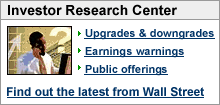Pfizer ups guidance, will boost pipelineNo. 1 drugmaker plans to file cholesterol combo with FDA in 2007 and expects four new filings every year from 2011GROTON, Conn. (CNNMoney.com) -- Pfizer's CEO raised the No. 1 drugmaker's earnings guidance for 2006, and executives said the company plans to triple its late-stage drug pipeline by 2009. Pfizer chief executive Jeffrey Kindler said Thursday that he had raised the company earnings guidance to $2.05 per share for 2006 from the previous guidance of $2.
"We're maximizing our current performance," said Kindler to a gathering of analysts at the company's R&D facility in Groton, Conn. "We've moving towards a flexible, lower cost structure. Pfizer also said it plans to have annual EPS in 2007 and 2008 grow by percentages in the "high single digits." After Pfizer raised its guidance, Deutsche Bank analyst Barbara Ryan slightly raised EPS projections for 2006, to $2.05 from $2.02. Ryan also raised estimates for 2007, to $2.20 from $2.15, and for 2008, to $2.37 from $2.29. John LaMattina, president of global research and development, said that Pfizer (up $0.42 to $27.49, Charts) plans to triple its number of experimental drugs in phase 3 by 2009. This is the latest phase of development before submission to the Food and Drug Administration. Kindler, the newly appointed CEO, said that by 2011 his company plans to generate a "steady stream" of four new products a year. "That's when the tsunami hits, 2011," LaMattina said in a press conference with reporters. "Everything we're pointing to really starts hitting in 2011." Kindler described the current pipeline as "extraordinarily robust," with 242 programs in 11 therapeutic areas. "We've made significant scientific break-throughs and we're hungry for more," said Kindler, adding that there was "real momentum" in the pipeline. LaMattina said the company had a heart disease drug in phase 3 trials, one cancer drug in phase 3 and one in phase 2, a liver disease drug in phase 2, and an arthritis drug in phase 2. In addition, Pfizer was studying the drug Lyrica, already on the market for nerve pain related to diabetes and shingles, for the treatment of fibromyalgia, a chronic pain illness. The company also has Maraviroc, an HIV drug it plans to file with the FDA in December. Kindler said he plans to file the experimental Lipitor-torcetrapib combination with the FDA in the second half of 2007. This combination adds cholesterol-cutting Lipitor, the world's top-selling drug with $12.2 billion in 2005 sales, to torcetrapib, which is being tested to increase high-density lipoprotein, HDL, also known as "good" cholesterol. Analysts' projections about the Lipitor-torcetrapib combo vary, from adding billions of dollars in annual sales to Lipitor to cannibalizing them away from Lipitor while creating a modest overall gain in revenue. LaMattina noted that the possibility of losing Lipitor sales to the combo is mitigated by the fact that Lipitor's patent is scheduled to run out in 2011. This provides a somewhat narrow window between the possible FDA approval of the combo and the Lipitor patent expiration. "There won't be much cannibalization left because Lipitor goes off patent in 2011," said LaMattina, who referred to the experimental combo as "a major new therapy" and "the next generation" in cholesterol control. Kindler promised that Pfizer will be more transparent in informing the public about the earlier stages of its pipeline and will soon begin posting this information on the company Web site. The previous CEO, Henry McKinnell, angered and alienated investors and analysts when he pulled guidance figures in 2005. Les Funtleyder, analyst for Miller Tabak, commented that Kindler's new approach of increased transparency could bump up the stock price as much as 10 percent. "Transparency gets rid of the lack of visibility discount that has hung over the stock the last couple years," said Funtleyder. Pfizer and the No. 4 U.S. drugmaker, Merck (down $0.05 to $44.51, Charts), have been under increasing pressure to bolster their pipelines as blockbusters lose patent protection, such as Pfizer's antidepressant Zoloft and Merck's cholesterol cutter Zocor did earlier this year. Also, the companies are both engaged in multibillion-dollar cost-cutting efforts. But analysts say that the drugmakers need new blockbusters, not just corporate streamlining, to deliver strong growth. On Tuesday, just two days before the analyst meeting, Kindler announced that Pfizer would cut 20 percent of its 11,000-strong U.S. sales staff. Asked by a reporter when Pfizer will hire back the lost sales reps, Kindler replied: "We believe that the point has come where we can be more effective with a reconfigured sales force." Kindler said it is more effective for a sales rep to spend a 30-minute session with a doctor every couple of weeks than to make more frequent, but brief, visits where the sales rep drops off drug samples at the office. Funtleyder does not own Pfizer stock, and Miller Tabak does not conduct investment banking with the company. Ryan does not own shares of Pfizer stock, but Deutsche Bank North America may have conducted investment banking with the company in the past 12 months. |
|


